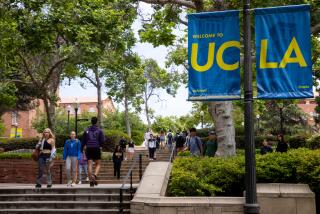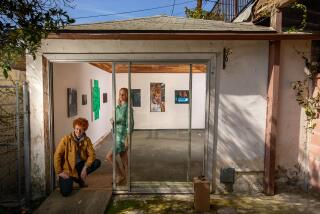O.C. ART : She Plans a Splash of Color for Art Department at UCI : Catherine Lord’s appointment could mean the end to department’s laid-back reputation. She enjoys controversy and is known as a social activist.
- Share via
“Schools are places where you can have arguments,” says Catherine Lord, the dryly iconoclastic new chairman of the art department at UC Irvine.
“You learn by seeing other people argue. For me, it’s a business of getting people to articulate their ideas--not just verbalize them, but articulate them in their work and have a stake in them. Students need to figure out how much they care and what the price of caring is.”
Lord, 42, is a social activist in the visual arts. Last year she edited the catalogue for an exhibition of lesbian art, “All but the Obvious,” at Los Angeles Contemporary Exhibitions. Four years ago, she was co-juror (with Joan Hugo) of “Artists Recall,” an exhibit organized by the Los Angeles Artists Coalition Against U.S. Intervention in Central America.
At California Institute of the Arts in Valencia, where Lord was dean of the School of Art for seven years before coming to UCI, she sometimes clashed with faculty members whose interests were exclusively theoretical and aesthetic. An abstract painter who was fired from CalArts during Lord’s tenure claims that Lord was interested only in “power and the promotion of her political point of view.”
Lord responds that CalArts had been “quite one-sided in its definition of art” before her arrival. “It was a faculty that was entirely white and mostly male. That fact had been of some concern to students and the office of the president. My interest there was to build a program where a lot of arguments between quite different people could go on. . . . By the time I left, a range of (art)--from work addressing formal concerns to work that was explicitly political--was represented.”
Although the UCI art department was a hotbed of radical innovation in the early ‘70s (when one of its students was performance artist Chris Burden), its profile has been much lower in recent years, while CalArts and the Art Center College of Design in Pasadena have been funneling smart young artists into Los Angeles galleries. But the easygoing, low-key years at UCI may be over now that Lord has arrived.
Her most visible stamp can be seen in the gallery exhibition lineup for the 1991-92 academic year. (Gallery director Melinda Wortz is on indefinite medical leave.) Lord plans to make more room for student art and program more performance art and video. She says she will also “put a priority on showing work that is important and might not be shown elsewhere--work by artists who are ethnic minorities, women, gay and lesbian artists (as well as) important historical shows, independently curated.
“What would unify all those things is not some sort of pragmatic idea of introducing ‘affirmative action’ to the art world, but ideas about culture--that it is contested, oppositional; that it isn’t stable.”
The first exhibit of the fall quarter, “And 22 Million Very Tired and Very Angry People” (Oct. 3 through Nov. 7), is an installation by Carrie Mae Weems, a black photographer who makes spare work about the experiences of black Americans. Student exhibits are scheduled for Nov. 12 through Dec. 5. In winter quarter, “Convergence: Eight Photographers” (Jan. 7 through Feb. 4)--organized by Deborah Willis, curator of the Schoenberg Center of Black American Art in New York--brings together images by black artists working in different styles and dealing with diverse subject matter.
After more student exhibits (Feb. 11 through March 12), the gallery will show Deborah Bright’s photographic installation, “Chicago Stories,” which focuses on the Chicago Tribune and its labor history. The academic year ends with another student show (May 1 to mid-June).
Asked about the overwhelming emphasis on work with a social theme, Lord said, “I think there’s been a lot of work available in the rest of Orange County that is by white people and by men, work that proposes a formal agenda rather than a socially aware agenda.
“I don’t feel this year a need to show more of that work, although I expect that in future years there would be more of a range of work shown, (for example) in terms of media other than photography.”
Calling herself “a feminist with a sense of humor,” Lord dismisses charges of being a “politically correct” zealot. “Lousy political art” doesn’t interest her, she says, nor does “being told what to think.” The ideal? “A place where there can be (amicable) differences among artists who perceive themselves as equals and who are doing different (kinds of) work.”
Lord’s background is a mixture of “the best of a classical liberal arts education”--at Radcliffe College, where she majored in English--and the heady days of counterculture arts journalism. She earned her master’s of fine arts degree in photography and the history of photography at the Visual Studies Workshop, an artists’ organization allied with the State University of New York at Buffalo, where she also edited Afterimage, a journal of photography, film and video.
“I did everything: wrote, edited, raised money,” Lord says. “It was very much a job about . . . (enabling) people to print things they couldn’t print elsewhere, (an environment) where people had serious arguments with each other and took each other seriously, without silly boundaries between disciplines . . .
“Then somebody called me up and asked if I was interested in the CalArts job. I was 34 years old. . . . I was flattered, but I (thought I) wasn’t old enough. I wasn’t diplomatic enough. I wasn’t a management type. I wasn’t interested in selling out.”
She agreed to fly out and take a look, however, and felt it was “possible to do the job without totally distorting my interests and personality.” When the UCI position came up, “it was a chance to think about something else. My worst job fear is being bored.”
Lord praises UCI Dean Robert Hickok as “really supportive in terms of pulling resources into the department.” During the next five years, just under 20,000 additional square feet will be added for more student and faculty studios and for a separate student art gallery. Lord says she wants students to use the university’s gallery space “more experimentally . . . to do things they think might work that actually might not work.”
Hickok is also adding “substantial infusions” of money (Lord wouldn’t say how much) to build state-of-the-art darkrooms and video labs, and he has been “enormously supportive” in making additional visiting faculty and technical and support staff a high priority.
Visiting instructors--usually hired for a quarter or two, sometimes for the academic year--are “people with quite different styles, but none of them are laid back,” Lord says. “All of them are going to demand . . . I think it’s important to have (instructors) with distinct positions who are willing to engage with other people who have distinct positions, versus a monolithic front.”
Admission standards to the two-year master of fine arts studio art program are high: Only four of the 70 applicants were accepted for the fall 1991 term.
“When they get here, we tell them: ‘Look, it’s going to be really hard,’ ” Lord says. “The best I could teach somebody is how to be serious about what they most care about in a sustained way, to understand . . . that you may make it right away . . . or nothing may happen to you for 10 years.”
At UCI, Lord teaches an art theory class which she punningly calls “Loading the Canon.” The bellicose-sounding title has to do with one of the most hotly debated topics on U.S. campuses today: Whether the canon--the core list of ideas and subjects around which a curriculum is composed--ought to contain works by non-Western, “marginal” groups as well as the familiar Western classics.
The course asks important questions that were not being discussed in a formal way in the art department, Lord said, such as: Who defines the margins and who defines the center? What is it like to be in both these positions? Why are race, gender and sexual preference huge issues in the art world right now? How they are played out, in work that is and work that isn’t directly about those issues?
“I’m trying to set up a situation in which people in class can look at how values about art and culture get made and what the assumptions are,” Lord says. “Whoever felt totally comfortable about one (set of assumptions) would feel totally uncomfortable about another. . . . For those who are used to being at the top of the pecking order, for whatever reason, it’s different to be in a position where someone is always challenging you.” Different, and useful. It’s the kind of fruitful disquiet Lord clearly enjoys.
More to Read
The biggest entertainment stories
Get our big stories about Hollywood, film, television, music, arts, culture and more right in your inbox as soon as they publish.
You may occasionally receive promotional content from the Los Angeles Times.










